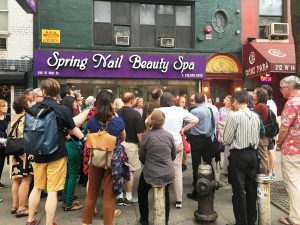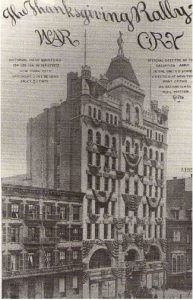A Stroll Down West 14th Street: Religious Architecture
West 14th Street has a multi-layered history, preserved in its architecture, which reflects the development of the surrounding area as well as New York City itself. West 14th Street is also a border street, separating Greenwich Village to the south from Chelsea to the north. Save Chelsea’s President Laurence Frommer and I teamed up for a walking tour of this thoroughfare last month entitled Planning and Preservation on West 14th Street, one of the MAS Jane’s Walk tours. Our tour only spanned from Sixth Avenue to Ninth Avenue, but nonetheless featured a variety of different building types, styles and periods. In this series, A Stroll Down West 14th Street, we look at three types of buildings we saw: residential, commercial/manufacturing, and religious. Today, we’re showcasing the religious buildings.

Like the residential and commercial architecture along West 14th Street, the religious buildings still seen today reflect the street’s and surrounding area’s evolution from an upper class to upper-middle class residential area in the mid-19th century to a commercial one with multifamily residences accommodating the largely immigrant community in the latter half of the 19th century into the 20th century. Original institutional buildings along 14th Street in the mid-19th century were primarily protestant churches servicing the residents in the area at that time. As the demographics of the area began to change, churches which catered to the now largely immigrant working-class residents were built to serve the spiritual needs of that population.

St. Bernard’s Roman Catholic Church (now Our Lady of Guadalupe at St. Bernard’s Church) located at 330 West 14th Street was built in 1873-1876 to accommodate a congregation made mostly of Irish and Irish-American parishioners who had outgrown their former smaller church on West 13th Street and Tenth Avenue. St. Bernard’s parish was first organized in 1868 by Reverend Gabriel A. Healy for the growing Irish population around the Greenwich Village and Chelsea areas. The church on West 14th Street was designed by Irish-born Patrick Charles Keely (1816-1896) who is credited with over 600 ecclesiastical designs across this country and beyond.
St. Bernard’s is an exceptional example of nineteenth-century ecclesiastic architecture. Designed in the Victorian Gothic style with a blend of French and English influences, this masonry structure is on the south side of West 14th Street and dominates the center of the block between Eighth and Ninth Avenues. It is rectilinear in plan and has a granite base. The rest of the exterior is clad in a mixture of textured limestone and brownstone blocks. The front gable slate roof is intact as are the exceptional stained glass windows and gothic arch openings throughout. There are twin square towers with limestone quoins at either end of the symmetrical façade. The triple portal entrance features carved oak double doors and panels as well as stained glass transoms. The façade is dominated by a large rose window inset into a gothic arch.
Other ethnic communities also established Catholic parishes around Greenwich Village, including Spanish immigrants. By the turn of the last century, a small community of Spanish Catholics had established themselves in the area near the Hudson River south of 14th Street, known as ‘Little Spain’. This community was compromised of mostly immigrants from Galicia. While by 1930 this presence had all but disappeared, in 1902 it was sufficient enough to lead to the establishment of Our Lady of Guadalupe. It was founded as the national parish for all Spanish-speaking Catholics in New York City and entrusted to the Augustinians of the Assumption, a small French religious community which included a number of Spanish-speaking members. The church for this parish was two converted 1854 brownstones at 229-231 West 14th Street (one of which was the former home of Charles Delmonico) and re-designed for the Spanish church by Gustave Steinback in 1921.

By 2003 St. Bernard’s parish population was scant and Our Lady of Guadalupe’s parish was much larger than their church could accommodate, largely due to the significant numbers of Mexican and South American immigrants to New York City. The Parishes were merged and the Our Lady of Guadalupe parish moved into St. Bernards, adopting the name Our Lady of Guadalupe at St. Bernard’s.
A significant institutional and religious presence is the American headquarters of the Salvation Army which has made West 14th Street its home since 1895. The Salvation Army is an international religious and charitable organization started in England in 1865 by William and Catherine Booth. The Salvation Army began outreach in New York in 1880, expanding rapidly here and in other U.S. cities. In 1895, it erected an auditorium and office building on part of this site, but by the 1920s a larger headquarters was needed to serve a wider variety of purposes.

The 1895 building of the Salvation Army Territorial Headquarters was replaced by a stunning group of Art Deco style buildings designed by renowned architect Ralph Walker of Voorhees, Gmelin, and Walker, built between 1928 and 1935. The complex consists of the eleven-story office tower and four-story auditorium – both facing West 14th street – and a dormitory facing West 13th Street (the latter of which is included in the Greenwich Village Historic District). All employ concrete, buff-colored brick, and cast stone trim. Together they stand as fine examples of their time. Indeed, they exude a level of elegance befitting the United States at the tail end of the Roaring Twenties just before the Stock Market Crash of 1929. Its Art Deco features include beautiful geometric floral ornamentation at the roofline, soaring verticality at the eleven-story office tower, and an ornate monumental entry at the four-story auditorium. In October of 2017, it was designated as a New York City Landmark (click HERE for the designation report).

So as you can see, West 14th Street offers a wide variety of building types, stunning architecture, and vivid history. Even if you missed the tour, take a stroll of your own and enjoy the sites!

One response to “A Stroll Down West 14th Street: Religious Architecture”